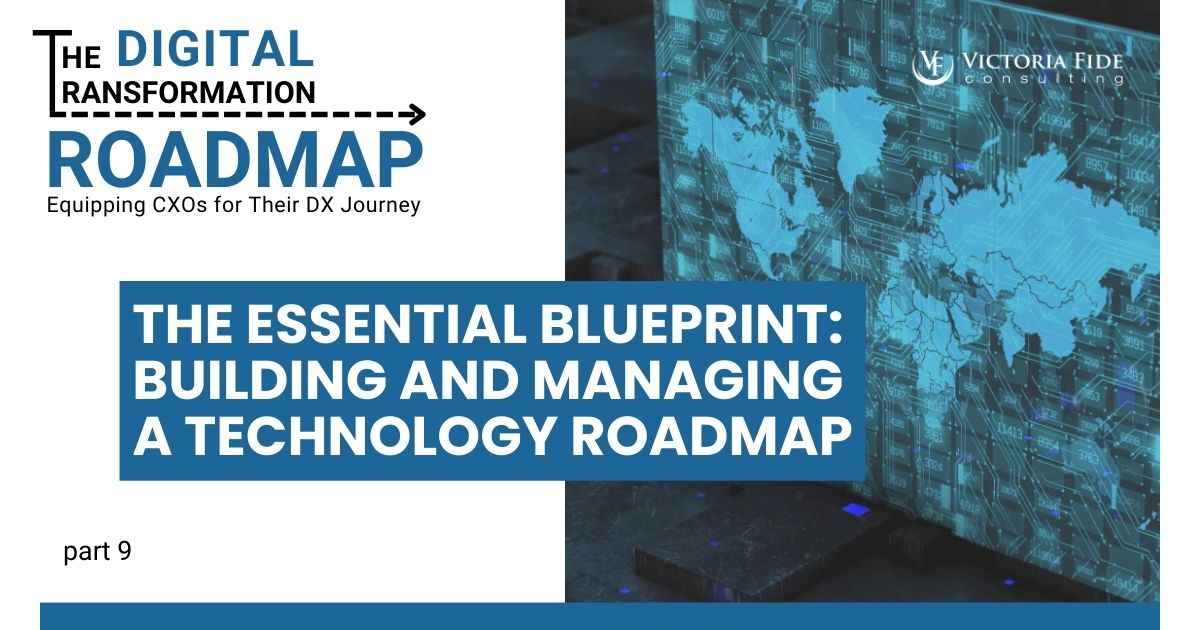
The Essential Blueprint: Building and Managing a Technology Roadmap
The DX Roadmap series is produced by Victoria Fide Marketing with input and oversight from our leadership team and industry SMEs.
Table of Contents
Not too long ago, embarking on a road trip involved either wrestling with a paper map that never quite folded up the same way, or relying on multiple sheets of directions printed from MapQuest. Today we are fortunate to have GPS effortlessly guiding us from point A to B and suggesting detours based on road construction or traffic updates. Regardless of the navigation method, planning your route and referencing it along the way are crucial in ensuring you reach your destination.
When it comes to your digital transformation (DX) journey, a technology roadmap is an essential artifact used to map your path toward your organizational goals. When used effectively, the technology roadmap will allow you to manage resources, unite team members toward one goal, and facilitate an effective change management strategy. It lays out all planned initiatives and is a critical tool for annual planning and budgeting, as well as risk mitigation and communication strategies.
If you’re prepared to chart the course toward your transformative goals, this guide is for you. In this article, we’ll discuss what a technology roadmap is, why it’s crucial for your DX journey, and how to create and maintain one effectively in order to reach your transformational destination.
The Technology Roadmap: Understanding your Digital Navigational Tool
A technology roadmap is an artifact that outlines an organization’s tech adoption plan, detailing budget, milestones, risks, and more. It covers specific details for initial project phases and general outlines for future ones. An effective roadmap not only documents the list of planned implementations and what is needed to complete them, but more importantly it describes how each of these projects support the overarching organizational goals, enabling future planning and effective portfolio management.
However, the biggest reason why a technology roadmap is so critical is that it ensures each department, team and team member is aligning their individual and collective efforts around the organizational priorities. With a clear, prioritized roadmap, leaders are able to effectively communicate not just the overarching strategy of the company, but how each individual fits into that strategy.
This organizational change management (OCM) piece is often overlooked when building a technology roadmap, but it is no less critical for its efficacy. The roadmap needs to communicate how your people will be equipped to handle these changes with technology, based on the results from the organizational maturity and risk assessments. This broad overview will be the bedrock upon which your OCM strategy will be built, empowering your team to take ownership of the changes and propel your organization to greater maturity, resilience, and success.
Exploring the Advantages of a Technology Roadmap
The benefits of creating and implementing a technology roadmap extend far beyond just aligning with organizational goals and priorities. Not only does it ensure that your technology efforts are working to support the bigger picture, but it also promotes effective communication channels, helps manage interdependencies between different teams and departments, breaks down silos that hinder collaboration, reduces the level of risk associated with technological changes, and fosters stronger interpersonal trust within your team while also boosting morale and productivity levels. In short, putting in the work to outline a technology roadmap, communicate it to your team and ensure it is well-maintained significantly reduces your chances of making costly, detrimental mistakes.
As you can imagine, neglecting to build or follow a technology roadmap can result in the direct opposite of all the benefits listed above. However, arguably the biggest danger in neglecting this critical piece lies in the damage it can cause to your teams. If deadlines are continually pushed out or milestones and requirements added, it erodes people’s trust in the leadership, the organization, and each other. It increases frustration and causes a sense of stagnation. It is incredibly important to maintain motivation and morale, and that is done by setting accurate goals, milestones and deadlines and then meeting them consistently, all of which cannot be accomplished without an effective technology roadmap.
Not following the roadmap results in misalignment between projects and organizational priorities, leading to wasted resources and ultimately, project failure. Without a well-maintained roadmap, you risk losing sight of the bigger picture, getting bogged down in unnecessary details or side projects that do not contribute to the overall goals, and losing your team’s trust and respect, which will crumble your organization’s culture.
6 Critical Elements of a Technology Roadmap
As we’ve stated, every effective technology roadmap should include a description of how the planned initiatives support organizational goals as well as how the people will be able to adopt the new technology successfully. Now let’s turn to the nitty gritty details: the technology initiatives themselves. Under each initiative listed in the roadmap, you should include 6 critical elements. While these elements can be included with varying degrees of detail, it is important to ensure all 6 are included for every opportunity on the roadmap.
Milestones & Releases
Listing all relevant milestones or applicable releases for each project assists in providing a rough timeline. However, this timeline will be reevaluated and updated as new information or additional requirements come to light. As a result, don’t worry about being specific with projects further down the road if you don’t have that information yet. Focus on being as specific as you can with projects closer to the front of the roadmap and be prepared to adapt.
Resource Planning
When considering the resources needed to fulfill a project, it is important to include a variety of resources, not just financial. Consider including team members responsible for the project and any external resources needed such as consultants or contractors. By clearly outlining resource needs at the beginning, you can better manage your budget and ensure the right people are available when needed.
Budget
Include an overview of the budget considerations for all expenses including people resources, equipment, software purchases, external consultants, travel, and any other expenses that the implementation may incur. Some additional expenses to consider are training materials and courses, lodging, and any miscellaneous project morale expenses. Don’t worry about fleshing out an entire project budget at this time – we will cover that step in more detail in a future article.
Training & Organizational Change Management
Change management is a critical component to a successful technology roadmap. Make sure to outline your organizational change management strategy in the roadmap including training plans and communication strategies. This will help ensure that everyone is on board with the changes and understands why they are necessary for the success of the organization. Without this step, user adoption will suffer, and your initiative will fail.

Transformation is not easy, but it doesn’t have to be impossible. Take control of your project’s success today and schedule a free 30-minute consultation to find out how Victoria Fide can equip you for transformational success.
Assumptions
As it is impossible to obtain all the necessary data at this time, you will need to make assumptions about things such as design and scope[example]. It is important to recognize, label and document these assumptions so that they can be challenged and revisited throughout the journey. For example, one assumption may be that all divisions utilize the same financial chart of accounts for consolidated reporting. The plan is then built around this assumption with the understanding that as additional information is gathered, the plan may need to change, and the technology roadmap updated.
Risk Factors
Call out any risk factors and known mitigation with as much specificity as possible. Risks may be general or specific in nature, with some having more obvious or immediate mitigation steps. For instance, a business that has a possibility of acquiring a regional competitor may put the overall timeline at risk. However, since there are no formal plans in place, it is a more general risk to keep aware of. A specific risk would be if an international organization were to implement a new retail solution with the need for maintaining real-time inventory tracking. We will cover risk mitigation in greater detail in a future article.
From Paper to Practice: Implementing Your Technology Strategy
The technology roadmap is your tool to ensure that every project and person is supporting the overarching objectives. However, a tool is only useful as long as it is being used. For a technology roadmap to be effective, it must be managed properly and updated consistently. Regularly review the roadmap with stakeholders to verify its accuracy and adherence. This will also assist in annual planning and budgeting, helping everyone stay on course and ensuring a smooth journey towards achieving transformation success.
While it is good to try and make the roadmap as accurate and specific as possible, you should expect to make changes. The technology roadmap is a living breathing document that should continuously evolve as the organization itself evolves. When something is identified as being outside of the technology roadmap, it is important to get back on track. In some cases, this requires integrating the new information into the roadmap, whether that’s a change of assumption, an added risk, or additional requirements for the project. In other cases, it may be necessary to terminate any project or initiative that falls outside of the roadmap.
Regularly review the roadmap and use it as a tool to get things back on track. Similar to a GPS rerouting you after taking a detour or a wrong turn, your technology roadmap should also adapt and shift to accommodate the changes and challenges that arise.

Evolution of the Technology Roadmap: Rerouting Your Path to Success
An effective technology roadmap is essential for any organization dedicated to continuous improvement, growth, and competitiveness. This roadmap is your blueprint to success, steering projects and people toward overarching organizational priorities and goals. Additionally, it is the foundation for an Organizational Change Management (OCM) strategy, fostering communication, alignment, and productivity.
It is important to recognize that building and maintaining a well-thought-out roadmap builds trust and collaboration within your team. Conversely, neglecting a roadmap can erode your culture and jeopardize the success of your digital transformation initiatives. Investing in a technology roadmap is one of the best ways to mitigate risks and set up your team for success.
As your organization’s needs and goals evolve, so should your roadmap, much like a GPS reroutes to keep you on the best possible route for your destination. Utilize your roadmap effectively, regularly review and update it, and communicate its importance to all stakeholders.
Subscribe to our LinkedIn newsletter for insights and practical tips to help you succeed in your self-directed digital transformation (DX) initiatives, and join us next week as we guide you through the process of creating a project portfolio.
Subscribe to our weekly LinkedIn Digital Transformation Success newsletter and get notified of each new edition.
